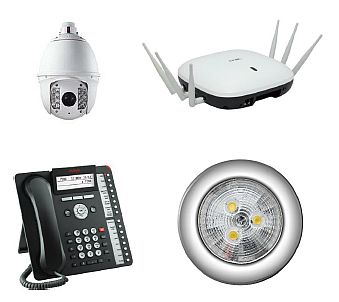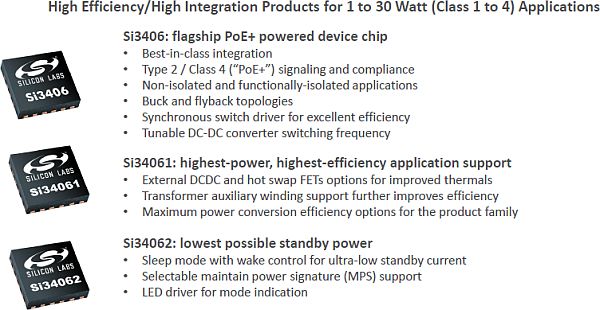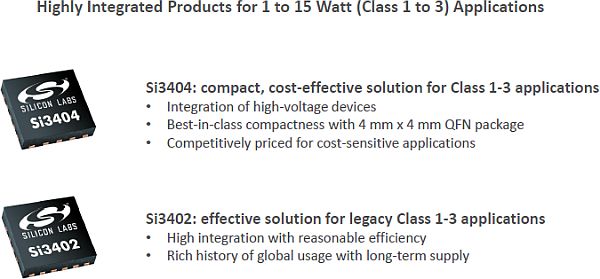
Silicon Labs (also known as " core technology " ) is a family of two new Power over Ethernet ( PoE ) devices ( PDs ) - the Si3406x and Si3404 . These devices are highly integrated and efficient for a wide range of IoT applications. The family has all the necessary high-voltage discrete components on a single PD chip and fully supports IEEE 802.3 PoE+ power functions with flexible power conversion options, over 90 % efficiency , sleep / wake /LED support modes, and excellent immunity to electromagnetic interference. .
During the period, Mr. John Wilson , senior manager of Silicon Labs ' PoE products , also accepted an industry media interview, from the design challenges and development trends of the current PoEPD system, and then introduced the advantages of Silicon Labs ' PoEPD devices that can meet these demanding requirements. Welcome to read or click " Read the original " to our Chinese community to view the full article.
Next generation PoE PD systems will see limitations and delays
The design of the next generation of IoT requires more power. John Wilson, senior manager of Silicon Labs ' PoE products, talked about the new developments in PD equipment presented at APEC this year . For PoE , 2018 will be a big year, as next-generation standards are expected to be approved by the IEEE committee around June or July . This new standard will increase the power level to 100W , which will be crucial for the lighting market.

IP cameras using PoE of FIG. 1, a wireless access point, IP phones and smart lighting
Companies like Philips already have LED PoE lighting products, which will be their advantage, and for other lighting companies, they also want to develop smart lighting with PoE and sensors, which may be available via Ethernet. Information such as temperature and humidity. These analytical data are very important to the retail sector and can help salespeople understand the areas of concern to customers at the time. This can indicate that most customers spend a lot of time in front of the store, but most of the salespeople are behind the store. Based on the illumination structure PoE PoE power IoT and / intelligent network key value portion. SiliconLabs currently has 30W products on the market .
The camera's security and surveillance cameras have an annual growth rate of more than 20 % year-on-year ; wireless access points have an annual growth rate of 15 % (wireless access points include feature-rich video IP phones, public hotspots, advanced 802.11 wireless access points) And smart appliances)
Designers like this device with higher integration and good power conversion efficiency solutions, and Silicon Labs excels in these areas. Traditional products have on-chip high voltages, such as transient voltage suppressors, input diode bridges, and power MOSFETs that can be directly connected to an Ethernet RJ-45 connector. At the same time, the company has increased the power conversion efficiency of these new ICs from the traditional 70 % to 90 %. These ICs also support isolation and EMI has been greatly improved, thus speeding up time to market.
These applications require higher wattages to address the growing demand for higher demand for PD devices that support the PoE+ standard . For example, the latest state- of-the-art motorized IP cameras with pan / tilt / zoom and with heating elements can place heavy loads on the power supply. PoE+ technology's 30W power can support these demanding application tasks. In addition, surge recovery capability of up to 4kV is also critical, especially in the Chinese market, where Ethernet cables are deployed externally to the camera equipment. These cables operate inside the building to the potential for potential lightning strikes. To prevent potential lightning strikes. For example IP camera power supply unit, see Figure 2.

Figure 2 Complete IP Camera Power Reference Design System Using Si3406x PD Devices (Photo courtesy of SiliconLabs )
The ideal solution for next-generation PoE design - Si3406x, Si3404
Silicon Labs' Si3406x series is ideal PD interface solutions for residential, commercial and industrial environments, the new PoE + support of IoT product.

Figure 3 This product portfolio addresses the challenges of all PoE+ PD use cases
The series also integrates all the power management and control functions required for PoE+ PD applications, converting the high voltage provided by the 10/100/1000BASE-T Ethernet connection to a regulated low voltage output supply. The new architecture minimizes PCB footprint and external BOM cost while maintaining high performance by using cost-effective external components while maintaining high performance.
The regulator's switching frequency can be adjusted with a simple external resistor value to avoid unwanted harmonics. An integrated synchronous driver can control the secondary side field effect transistor ( FET ) to improve power conversion efficiency. The connection to the PSE switch is maintained in sleep mode by the Automatic Maintenance Power Signature ( MPS ) feature .
As a supplement Si3406x series, Si3404 IC provides a cost-effective support in line with 802.3 Type 1 standard for low-power 15W PoE PD applications. The Si3404 contains all the interface and control functions required for low power PD applications in a small footprint .

Figure 4 Si3404 and Si3402 product advantages
Silicon Labs also offers a variety of PoE PD reference designs to help designers bring critical power subsystems to market faster.
Evaluation board and technical support
Sample and bulk products for the Si3406x IC are available in a small 5x 5 mm QFN package, and the Si3404 device is now available in a small 4 x 4 mm QFN package. To help developers reduce development time and reduce costs, Silicon Labs offers a range of isolated and non-isolated Class 2-4 evaluation kits for the Si3406x and Si3404 devices .

Figure 5: Si304 PD Buck Class 2 Evaluation Board; in FIG. 5 Class 3 Si3404 to the high power Class 4 Si34061EVB
Class 2-4 Development Kit
·       Si3404 Isolated Class 3 Evaluation Kit Si3404ISOC3-KIT
·       Si3404 Buck Class 2 Evaluation Kit Si3404BKC2-KIT
·       Si3406 Non-IsoFlybackClass 2 Evaluation Kit Si3406FBC2-KIT
·       Si3406 Non-IsoFlybackClass 3 Evaluation Kit Si3406FBC3-KIT
·       Si34061 Isolated Class 4 Evaluation Kit Si34061ISOC4
Lithium-boron Alloy is a composite material composed of a brittle Li7B6 matrix phase with a porous structure and a ductile Li filling phase. The density is 0.88±0.04g/cm3. The appearance is silver-white metal. It is extremely unstable. It is easily deteriorated when exposed to air and reacts with water. severe. Lithium-boron alloy is mainly used as anode material for lithium-based thermal batteries. It has outstanding advantages such as high specific energy, high specific power and low polarization, electrochemical potential similar to that of pure lithium, and solid state above 600℃. It is a new type of lithium-based thermal battery. The excellent negative electrode material. Compared with the currently widely used lithium-silicon alloy, the unit cell assembled with the lithium-boron alloy as the negative electrode material has better performance in both the highest voltage and the discharge working time.
Shandong Huachuang Times Optoelectronics Technology Co., Ltd. , https://www.dadncell.com